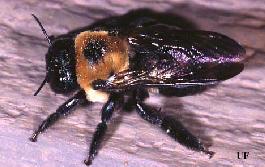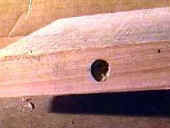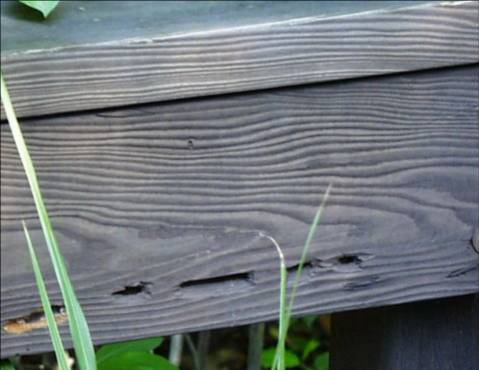| CARPENTER BEE |
 |
 |
 |
| LIFE CYCLE INFORMATION |
|
GENERAL INFORMATION: Carpenter bees (Xylocopa virginica) are very active from early spring through summer around houses and other wooden structures. These insects bore ½-inch wide holes that appear to be perfectly round on exterior wooden surfaces of house siding, eaves, window trim, fascia boards, shingles, decks and outdoor furniture. Homeowners are often frightened by these pesky black bees that fly erratically around their homes. The male carpenter bee is very territorial and protects its nesting sites by hovering and attacking intruders. Although the male is aggressive, it does not have a stinger, making it harmless. The female does have a stinger, but rarely stings. IDENTIFICATION: Homeowners often refer to these large, dark colored insects as bumble bees because of their similarities in size and appearance. Carpenter bees nest in excavated wooden tunnels. Bumble bees nest in the ground. Carpenter bees are robust, heavy-bodied bees that range ¾ to 1 inch in length. The carpenter bee can be identified by having bright yellow, orange or white hairs on the thorax and a black shiny abdomen. The bumble bee has a hairy abdomen, black or yellow in color. The male carpenter bee can be identified by having white markings on the head. LIFE CYCLE Adult female and male carpenter bees survive the winter in abandoned nest tunnels in which they have stored small amounts of pollen. The adults emerge in the spring (April and May), to mate, and search for nest sites. Females may use an old abandoned nest tunnel or excavate a new gallery to lay her eggs within a series of six to eight cells. Females supply each cell with a mixture of pollen and nectar, lay an egg on the food mass and seal off each cell with chewed wood pulp. The egg hatches and the larva develops into the adult, which chews through the wall of the cell to emerge in late summer. ECONOMIC IMPACT: Carpenter bees are nuisance pests in most cases, but they can cause considerable structural damage from repeated colonization of the same area. Fine sawdust caused by the adult bee’s excavating activities during the spring of the year will normally be found lying on the ground beneath the gallery entrances. Repeated boring activities may result in unsightly stains caused by falling bee waste around the entrance hole. Homeowners often notice a buzzing or burrowing sound coming from within the wood this time of year. The excavating bee will bore directly into the wood with her mouthparts for about 1 inch, then turn sharply and bore at a 90° angle usually along the grain of the wood. Normally, the gallery will extend about 4 to 6 inches, but with repeated use galleries have measured 10 feet long. Nest sites made by a single bee result in slight damage. Repeated colonization over several years, however, may result in considerable damage. |